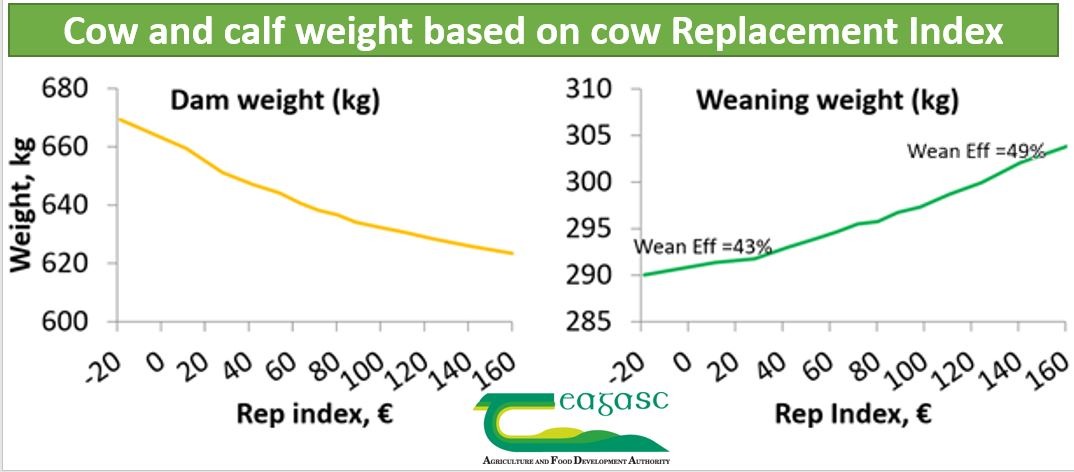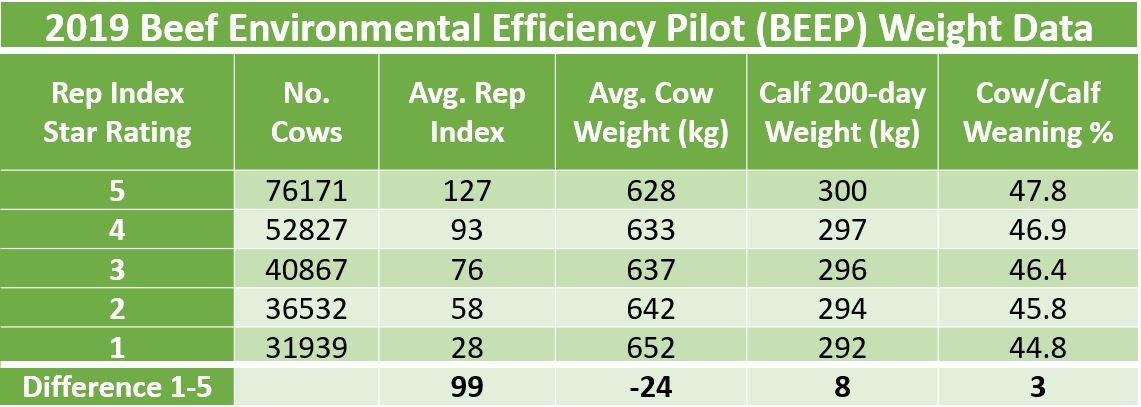This is clear from the results of analysis carried out by Teagasc on the data collected as part of the Beef Environmental Efficiency Pilot (BEEP) in 2019. Participating herds submitted weights to ICBF on their suckler cows and calves which saw approx. 780k cow and calf weights recorded in the ICBF database. Figure 1 demonstrates the relationship between the dam Replacement Index and both her own liveweight (graph A) and the weaning (200-day) weight of her calf (graph B). As the Replacement Index increases, cow liveweight decreases and calf weaning weight increases.

As part of this analysis all cows were adjusted to the same parity in order to remove the effect of age on cow performance which is non-genetic (e.g. a mature 5th calver will have an advantage over a 1st calver). All calves were also adjusted to a common sire to remove the effect on calf performance (e.g. cows mated to a high carcass merit sire will have an advantage over cows mated to a low carcass merit sire). This allowed for the analysis to reflect performance differences which could be attributed solely to the genetic merit of the dams. Table 1 gives a detailed breakdown of the performance of cows from 1-5 stars on the Replacement Index.

Looking at the differences between the 5-star and 1-star groups we can see that 5-star cows were 24kg lighter and produced calves that were 8kg heavier at weaning resulting in a cow/calf weaning % which is 3% higher.
What is the economic benefit of this?
If we again compare the 5-star and 1-star groups, we can see significant economic benefits to having higher Replacement Index cows. Mature animals will generally consume 2% of their own body weight in dry matter. Maintaining the extra 24kg of cow liveweight of an average 1-star cow will require 0.5 kg extra dry matter per day in feed. Over the course of a year, this equates to 182.5kg of extra dry matter. Grazed grass costs approx. 8 cents per kg of dry matter and grass silage costs approx. 17 cent. If a suckler cow spends 9 months of the year at grass (270 days) and the remaining 3 months (95 days) indoors eating silage, this equates to 135 extra kg of grass dry matter and 47.5 extra kg of silage dry matter. This will result in an extra cost of €10.80 in grass (135 x €0.08) and €8.10 in silage (47.5 x €0.17) giving a total of €18.90. This might not seem like a lot but when you multiply that by a herd of 20 cows it becomes significant. If you take the whole suckler sector and look at the potential impact on feed costs on 900k suckler cows, then €18.90 at a cow level grows to €17 million across the national herd.
8kg extra weaning weight will also generate more revenue. Even at a modest weanling price of €2/kg this equates to €16 per cow and over a 20 cow herd, an extra €320. Again, when the impact is looked at from an industry level across 900k cows the figure comes to €14.5 million.
Conclusion
The Replacement Index is delivering on key profit traits on Irish suckler farms. Continued farmer engagement in the form of comprehensive data recording and genotyping will accelerate the rate of genetic gain in our suckler herd which will drive on-farm performance and the associated economic benefits.

